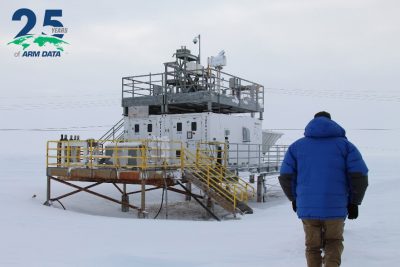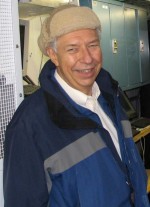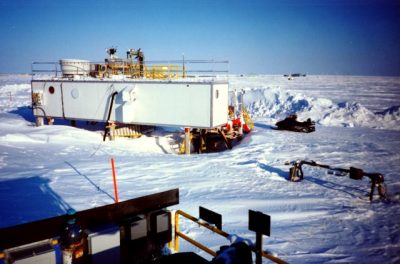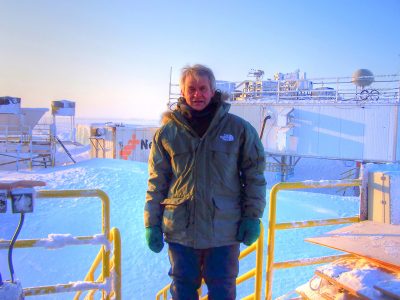Discover 20 Years of ARM Arctic Data
Published: 15 July 2017
ARM’s Barrow Observatory Reaches Milestone

This year, ARM’s Barrow, Alaska, atmospheric observatory celebrates its twentieth year of continuous operation, marking another important milestone in ARM’s 25-year history of collecting data.
The Barrow site began continuous operations in the summer of 1997, when the Surface Heat Budget of the Arctic Ocean (SHEBA) international field campaign kicked things off by deploying a suite of basic instruments that morphed over time into the site we know today.
ARM’s original site identification report called for setting up the Southern Great Plains (SGP) and Tropical Western Pacific (TWP) facilities first, followed by an arctic observatory. Even then, it was apparent that modelers and observers lacked extensive data sets for high latitudes, and ARM was determined to turn its attentions there.
Origins
In those early days, the Barrow site was managed by Bernie Zak, of Sandia National Laboratories (SNL), a dynamic leader with the vision and drive required for the pioneering phase. Zak is now retired from Sandia and works as a senior researcher at New Mexico State University.
Ably supported by Knut Stamnes, Barrow’s first site scientist and professor of physics at the University of Alaska Fairbanks, and Hans Eide, a Norwegian scientist who helped build the partnership with the University of Alaska, Fairbanks, Zak hit the ground running and never looked back.
Today, Barrow has a wider array of instruments than any other arctic research site and recently changed its name to Utqiaġvik. Canada and Russia maintain arctic research stations, but they lack Barrow’s breadth.
From Bear Guard to Site Manager


In 1999, Zak convinced part-time worker and invaluable jack-of-all-trades Walter Brower, a member of the local Iñupiat community, to take on a full-time role at the site, which previously was unmanned during weekends. Brower has been there ever since, handing everything from instrument set-up and calibration to technology troubleshooting and road maintenance.
Now Barrow’s resident site manager, Brower relies on operator/technician Jimmy Ivanoff as his right-hand man. Together, their competence, diligence, and ingenuity have kept the site running smoothly.
Brower and Ivanoff have done everything from help fabricate an automatic timed balloon launcher to repair instruments onsite with mentors talking them through procedures from thousands of miles away. They’ve also ensured the continuation of excellent relations with the Barrow community, which cooperates with ARM staff and has helped scientists navigate this initially unfamiliar and always challenging environment.
As Gijs de Boer, of University of Colorado, Boulder, and NOAA, Oliktok Point (Barrow’s sister site) science team leader, notes, “Work is not easy there. There are many logistical issues—getting around, power, keeping instruments functioning—that simply aren’t considerations at lower latitudes.”
Hans Verlinde, professor of meteorology at Pennsylvania State University and former ARM NSA site scientist adds: “You have to know the environment to plan ahead adequately. Take a new instrument, for example, being installed outside. The manufacturer perhaps never thought of it being used in the Arctic. But when Brower and Ivanoff see that it’s got a cover they’ll have to take off when it’s 40 below and impossible to use a screwdriver because the instrument’s covered with ice and they’re wearing mittens, they suggest changes. They know, because they’ve lived and worked there all their lives. Their knowledge is invaluable to the successful pursuit of our science.”
Barrow’s Continuing Impact
Two landmark ARM field campaigns that were important in validating ground-based observations in the Arctic were the Mixed-Phase Arctic Cloud Experiment (M-PACE) in fall 2004, led by Hans Verlinde, and the Indirect and Semi-Direct Aerosol Campaign (ISDAC), led by Steve Ghan of Pacific Northwest National Laboratory in spring 2008. These similar campaigns relied on correlating aircraft measurements with those taken at Barrow.

Over its history, the Barrow observatory has been instrumental in advancing understanding of arctic atmospheric processes, especially cloud properties unique to high latitudes. Many scientists, both U.S.-based and international, have contributed to this ongoing effort to unravel the mysteries of arctic clouds and surface radiative fluxes that have inhibited the accuracy of global atmospheric models.
“ARM’s work on the North Slope, at both Barrow and Oliktok, has changed the thinking about arctic and global processes,” de Boer says. “It’s accelerated the development of atmospheric system knowledge and improved models, especially about the critical surface energy budget.”
Barrow’s length and breadth of measurements are unique: no other arctic observatory can match its unbroken runs of superb data.
Enhancing the value of this record is the complementary work of neighboring observatories operated by NOAA and the U.S. Geological Survey (USGS). Both predate ARM at Barrow by several decades. Their presence made the site that more attractive to Zak and his SNL compatriots scouting the North Slope for likely locations.
Today, the three agencies share their power source, cooperate in maintaining roads, and work together in other ways. The USGS site is unmanned, simply recording magnetic data. The NOAA site monitors atmospheric constituents, especially ozone, while ARM focuses on radiation and atmospheric processes.
In the Eye of the Beholder
With only two seasons—“winter and almost winter” according to Brower—some researchers characterize Barrow as bleak. Others contrast it favorably with the industrialized landscape and airborne pollution of the Prudhoe Bay oilfields near Oliktok Point.
Barrow boasts cleaner air, with the prevailing northeast winds coming off the Beaufort Sea, but it too receives oilfield pollution 10 to 20% of the time. This contrast between the sites’ air quality is put to use for science, enabling ARM to compare aerosol impacts on clouds and processes.
The Far North has a way of weaving its spell on visitors, starting with the flight in over the pristine wilderness of the Brooks Range. Wildlife, as well as landscape and atmospherics, remains a magnificent spectacle in the region.

Caribou and migratory birds in their thousands offer unforgettable sights to scientists visiting ARM’s North Slope observatories. Everyone also agrees that members of Barrow’s Iñupiat community are always a pleasure to deal with.
Verlinde readily confesses: “You rapidly develop a deep affection for the Arctic.”
Wildlife can be a problem as well as an attraction, with polar bears tearing up fences and arctic foxes and lemmings chewing through power cables at the observatories.
Brower says the bears are inquisitive rather than deliberately destructive, whereas the amped-up foxes can detect electrical current and seem to like it: they never attack fiber optic cables. Research has also determined that they prefer red and blue cable armor, and don’t touch yellow.
Barrow has never had a bear incident involving staff, and only twice has the site been cleared because of bears wandering through.

Growing Interest in a Changing Arctic
Mark Ivey of SNL, ARM’s facility manager for the North Slope observatories, says Barrow has been popular with research scientists. He measures the site’s success by its use rate and the number of publications based on its amazing data record.
On these metrics, Barrow is second only to the flagship SGP among ARM observatories. Ivey and Dan Lucero (SNL), Barrow’s non-resident site manager, aim to keep hosting field campaigns, because they know that their facility exists for its users.
Jim Mather, ARM’s Technical Director, has been involved with North Slope activities since he took part in M-PACE at Oliktok Point in 2004. His first opportunity to visit Barrow came in 2014.
He notes that the site’s 20-year history coincides with a period of rapid change in the Arctic, and that these changes make it harder to plan science activities according to normal seasonal fluctuations.
Verlinde adds that the public too is now well aware of Arctic change and because of that interest supports ongoing atmospheric research there.
So at Barrow, ARM concentrates on keeping the data coming, and every day added enriches the value of what’s already been reaped.
The ARM Climate Research Facility is a DOE Office of Science user facility. The ARM Facility is operated by nine DOE national laboratories, including Sandia National Laboratories.
Keep up with the Atmospheric Observer
Updates on ARM news, events, and opportunities delivered to your inbox
ARM User Profile
ARM welcomes users from all institutions and nations. A free ARM user account is needed to access ARM data.


















